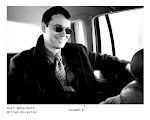• • •
Vita è breve, ma la vita artistica è da molto tempo.
-- Italian Proverb
This blog post was in large part inspired by Woody Allen, and his
prodigious output; the lessons I draw from his example will also
make clear why I did not follow my first impulse and call this
posting The Artist at Rest.
Why did I start this post by mentioning my inspiration for it?
Because I'd like to give my readers time to consider what they
think of Woody Allen's output for themselves before continuing.
TIME FOR REFLECTION
One of the least considered aspects of the artistic life is the
period between projects, the fallow time. These are difficult
times in the life of the artist, these periods of idleness, of
flatness which follow the excitement which accompanies the
culmination of a project.
As an artist finishes a book or a movie, or as her play gets
ready to go up, there's a rush of anticipation fed by the
feverish activity which is necessary to put the final polish
on a work before it goes out on its own into the world
and by the promise - or at least the potential - for receiving
some of the attention on which the artist ultimately lives.
If this attention comes, it extends the excitement of the
work beyond the period in which the artist was
fashioning it. This can be a very enjoyable period for
the artist if it doesn't go on too long. It can be the
stimulant which keeps him going through the lean
and difficult times. Of course the artist may be
involved in promoting or distributing the art too.
This can range from signing books at bookstores
to speaking after showings of your movie at the
Gene Siskel Center to sending e-mails to on-line
distributors or slides to galleries. Unfortunately, it
has become as much "the work" of the artist as the
creation of the work itself.
The nice thing about promoting your career or one
of your works is that it takes your mind off the fact
that you are not creating anything at the moment.
These periods may look like fun to outsiders, one of
the perks of the profession - or more accurately the
avocation, since so few artists make a living off their
work - like summer vacation for teachers; but for
most artists these periods of idleness are fraught with
anxiety.
Until a project engages the artist, she is adrift, at sea in
a boat without steering mechanism. At least that's how
it feels, and when the fallow period doesn't bring any
attention for the work, it's doubly difficult. Attention
for a work which has come out puts the artist at ease,
makes him feel his work is validated, worthwhile; and
it is if someone pays attention to it. Rejection and
silence, on the other hand, especially accompanying the
drifting feeling the artist lives with while waiting for a new
project to engage his attention, only brings his choice of
avocation further into question.
What if I never work again? she wonders. What if I've
shot my bolt?
Of course for most artists - those without a book contract
when they start their novel or gallery interested in their
paintings when they start a new series - it's not immediately
obvious if a work will find a modicum of success, say a
nice review, or not. They go through the period of trying
to interest the world in their work when it's done. It takes
patience and perseverance to survive such periods, but the
sense of purpose is at least still there, and it allows one to
stay busy during the fallows after a work is done.
Hopefully by the time one is done "selling and promoting,"
something new will have caught fire in the imagination,
something strong enough to mobilize the great energy it takes
to bring a new work into worthwhile being. Often though
the fallow period continues past the busy times, and the artist
just has to survive, journaling, doodling, working her social
media, until something new comes along.
There is a redeeming secret here though: the fallow periods
are necessary to full growth as an artist. Proust has pointed
out that laziness for artists is the opposite of laziness as
usually understood. For most people not keeping busy
is an avoidance of work. For artists keeping busy all the
time is the avoidance of the work of delving fully into
their own experience and excavating its significance.
That is why I began with Woody Allen. Because he has been
cursed with the ability to work whenever he wants to, and
because of his particular neuroses, he works at a feverish pace.
It has allowed him no periods in which to grow as an artist.
It's for this reason seemingly that the promise he showed
coming out of Annie Hall, Manhattan and Stardust Memories
has largely evaporated.
• ^•>
Subscribe to:
Post Comments (Atom)

No comments:
Post a Comment